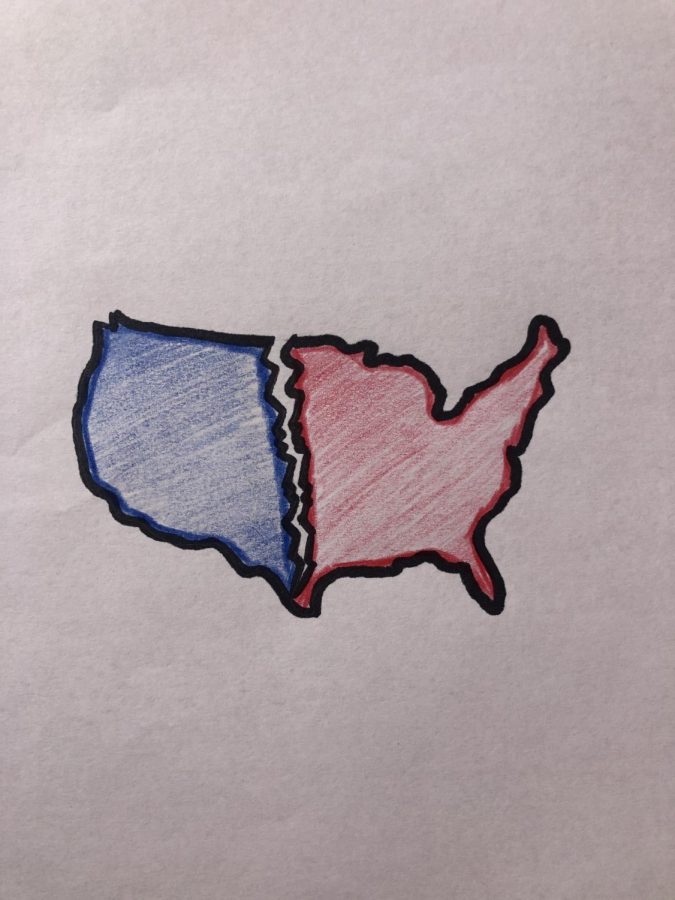America Faces Unprecedented Political Division this Election Year
September 21, 2020
By Kate Wiggins
Features Editor
As the 2020 elections approach, the United States has witnessed one of the largest political divides between Democrats and Republicans, causing high levels of tension between parties and large scale debates.
According to a political journal, a study by the Pew Research Center showed that division between Republicans and Democrats on basic political values such as government, race, immigration, national security, environmental protection, and other areas has reached record level highs during both the Obama and Trump presidencies.
“Since the widening of the political gap is a continuation of a trend, Trump’s presidency hasn’t ushered in a new era of intense political polarization so much as it marks a new chapter in an increasingly polarized political time,” said the Atlantic (theatlantic.com).
As the Pew Research Center explains it, members of both Democratic and Republican parties are having a stronger stance on the party’s core ideas. “92 percent of Republicans are to the right of the median Democrat, and 94 percent of Democrats are to the left of the median Republican (as of 2014)” (pewresearch.org).
A stronger disliking towards opposite parties has also risen over the past decade. In 1994, only 17 percent of Republicans and 16 percent of Democrats held negative views against the opposite party. As of 2014, those numbers have jumped dramatically to 43 percent of Republicans and 38 percent of Democrats view the opposing party in strongly negative terms (pewresearch.org)
One of the more visible and current examples of the Nation’s political polarization is the tension between the Democratic/liberal “Black Lives Matter” (BLM) movement and Republican/conservative communities who have created their “All Lives Matter” motto in retaliation. BLM Protests across the nation, only seven percent ending in some sort of violence or destruction, have sparked outrage inside much of the Republican circle and are not supported by President Trump (acleddata.com). Trump shared to his Twitter, “…yet the @NYCMayor [Bill de Blasio] is going to paint a big, expensive, yellow Black Lives Matter sign on Fifth Avenue… won’t let this symbol of hate be affixed to New York’s greatest street” (twitter.com).
Senior Hannah Griswold shared her thoughts on America’s political divide. “I believe that the large political divide in the 2020 election is created by the vast differences in information reported by partisan news sources, a deep distrust in science, and a lack of conversation between voters across party lines,” shared Griswold. Griswold encourages students to reach out to their peers with different political perspectives and have positive conversations about their fundamental values and specific political policies in order to create a better sense of understanding. “It takes bravery to have challenging and civil conversations, but it is imperative to creating a unified front in the face of this public health and economic crisis,” Griswold concluded.
A science-based magazine suggested that the impacts of polarization aren’t only limited to politics, but also to families, workplaces, schools, neighborhoods, and religious organizations (greatergood.berkeley.edu). Stanford University Professor of Sociology Robb Willer explained that political hostility can paralyze the federal government: “We need our federal government to function effectively if we are to tackle pressing domestic problems, support global political stability and address climate change. The cultural and interpersonal costs are also very real” (news.stanford.edu).
Research by the More in Common Foundation shows that about three-fourths of Americans recognize the divide and that “…our differences are not so great that we cannot come together,” leaving hope for potential reconciliation in the future (greatergood.berkeley.edu).
Willer explained that resolution could start with politicians listening and talking to each other in a more productive way. “We believe a technique called moral reframing can help,” said Willer. “Moral reframing” is explaining liberal ideas with ties to conservative morals, like patriotism and moral purity, and vice-versa (news.stanford.edu).


